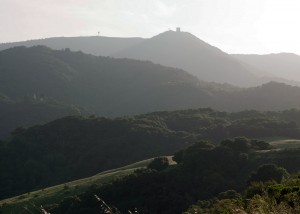For some folks, just going out and hiking a trail in a local park doesn’t have quite enough allure to compete with the virtual world of smart phones and laptops, Facebook and video games.
But what if exploring a local park meant using a high-tech gadget to search for hidden treasure and earn collectable “geocoins” — all while trekking through the real, wild world of a wilderness park?
That’s the idea behind the Midpeninsula Regional Open Space District’s new Preserve Circuit Geo-Challenge, kicking off this Saturday at Skyline Ridge Open Space Preserve, — to use geocaching to turn people, especially young people, on to the hybrid game-hike-sport.
The program is designed to bring together existing geocachers with newcomers who are interested in learning about the game. Geocachers of all skill levels are invited to participate in the geo-challenge.
“Geocaching is an activity that is reintroducing families and their kids to our natural spaces,” says Steve Wood of Recreational Equipment, Inc (REI). “It’s doing it in a way that is engaging all generations of the family so that everyone gets to go out and participate and learn what being in the outdoors is all about.”
Wood started geocaching himself in 2003 because it was an interesting way to explore the outdoors with his kids. Wood has worked closely with Williams to launch this Saturday’s event. REI will be offering guided hikes at the event for families new to geocaching.
On July 9, MROSD will release the list of coordinates for 22 caches in their preserve circuit. Geo-Challenge participants download map coordinates from geocaching.com onto a GPS unit and head out on a quest to find caches hidden along the trails.
A cache will often contain a logbook and objects for trade that appeal to young geocachers. If you take object from a cache, you need to replace it with an item of equal or greater value. Be sure to sign your name in the logbook and put the cache back the way you found it. When you get home, log on to geocaching.com with your user name and record the items you found and share your experience.
“All [caches] within our program will be full size and will be placed in a way that the newcomers will be able to find them without too much difficulty,” says Jennifer Williams of MROSD.
MROSD will also be handing out “preserve passports.” A unique stamp is placed inside the caches of this particular preserve circuit. With the stamp, you mark the corresponding preserve page on the inside of your passport. After the passport has been filled, you can submit it to MROSD to earn collectible geocoins, each imprinted with a serial number (you can keep the coins or leave them in a cache, and then follow the serial number later to see where the coin travels).
The goal of the program is not only to connect with the existing geocaching community but also to get kids out from behind their TV or computer screens and interacting with nature.
In 2007, MROSD formally recognized policies and guidelines for geocaching, which has allowed people to place caches in the district’s preserves and search for them.
Williams says a couple hundred people have said they’re coming to the event this Saturday, and the three geocaching clinics for newcomers have been filled.
But she still encourages newcomers to RSVP, a requirement for the event, and join in on the outdoor adventure. To RSVP, email vdavis@openspace.org or go to openspace.org/geocaching.

.jpg)


-300x173.jpg)
